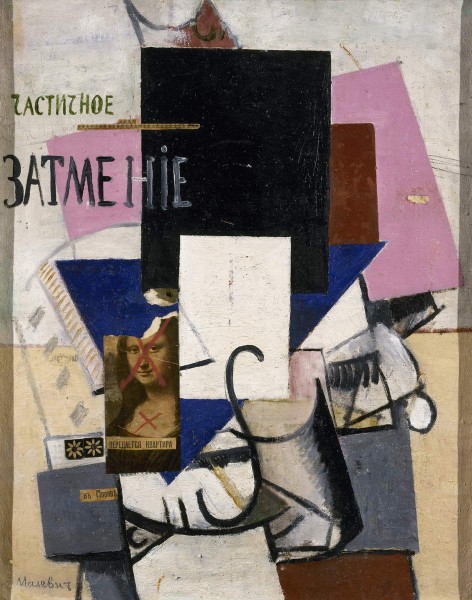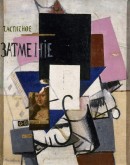Composition with La Gioconda (Partial Eclipse)
1914
- Canvas, paper, oil, graphite pencil. 62,5 x 49,3
- ЖС-440
Received in 1991 from Nina Suetina, Leningrad
- Period Early 20th century
- CategoryAbstraction
- Share
Kazimir Malevich’s painterly «alogisms», one of which is Composition with La Gioconda (Partial Eclipse), express to a considerable degree the general direction of the Russian avant-garde innovations. As Malevich’s contemporary, Benedikt Livshits, said: «The world opened in a whole new manner and this had to be narrated ... in all painterly tongues and dialects.» The combination of a detail of Leonardoda Vinci’s Mona Lisa, a scrap of newspaper and geometrical volumes and planes bearing incoherent inscriptions in the united organism of a canvas legitimised «absurdism» as an independent movement in Russian culture. Such absurdism was, incidentally, as prolific in poetry, literature and the theatre as it was in fine art. The absurd often took the form of an intellectual game. As a means of intuitively grasping the hidden essence of various phenomena, it offered opportunities for experimentation. The Russian avant-garde, Malevich included, shocked the public by overthrowing the former authorities and inventing «formulae» for their own personal selves. Russian Museum: From Icons to the Modern Times. Palace Editions, St Petersburg, 2015. P. 324.
In this painting, Malevich reproduces Leonardo da Vinci’s celebrated portrait of the Mona Lisa, although the subject herself is partially obscured by geometric forms and volumes that seem to move around the pictorial space. It is almost as though the artist is underlining his abandonment of classicism and his embracing of the New Realist approach. According to Malevich, he originally placed a cigarette between the Mona Lisa’s lips, although this detail has been lost over time. Nonetheless, this symbolic act also served to underline his ironic reappraisal of the work of the great Italian master. Intriguingly, the black and white rectangles accompanying the image of the Mona Lisa are placed on the same level as her portrait, or even positioned slightly above it. The effect is immediately eye-catching, and in a compositional sense these geometric shapes are presented as works of art of the same caliber as da Vinci’s masterpiece, or even superior to it. This impression is heightened by the fact that the Mona Lisa has been crossed out with red lines.
Show full textThe painting also includes an inscription, which translates to «Partial Eclipse». Perhaps it is an attempt to justify the artist’s boldness and audacity, by suggesting the natural phenomenon of the eclipse has caused him to go a little mad. The newspapers of the day attest to the fact that in 1914, when Malevich was immersed in the creation of this artwork, there was indeed a solar eclipse. However, by incorporating this inscription, Malevich was not only immortalizing this natural phenomenon: it also represents a commitment on the artist’s part to his relationship with the observer.
After painting this Composition with the Mona Lisa, Malevich was ready to move beyond the limitations of so-called «practical realism». «I have destroyed the ring of the horizon, and escaped the circle of objects. And now, everything has dissipated, like smoke», he wrote.

